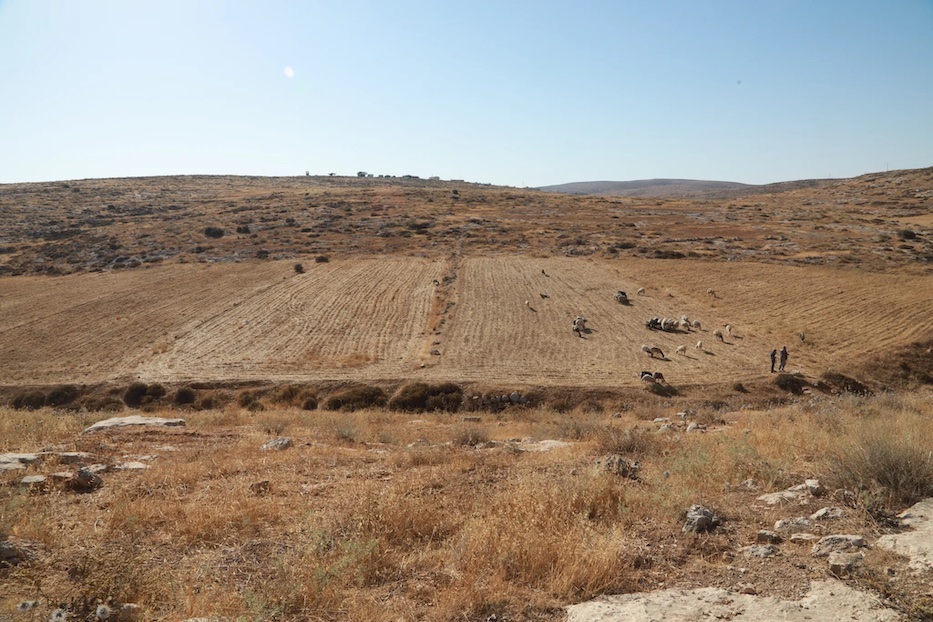
Culture & Community | Photography | Arts & Culture | Visual Arts | Arts & Anti-racism | Palestine
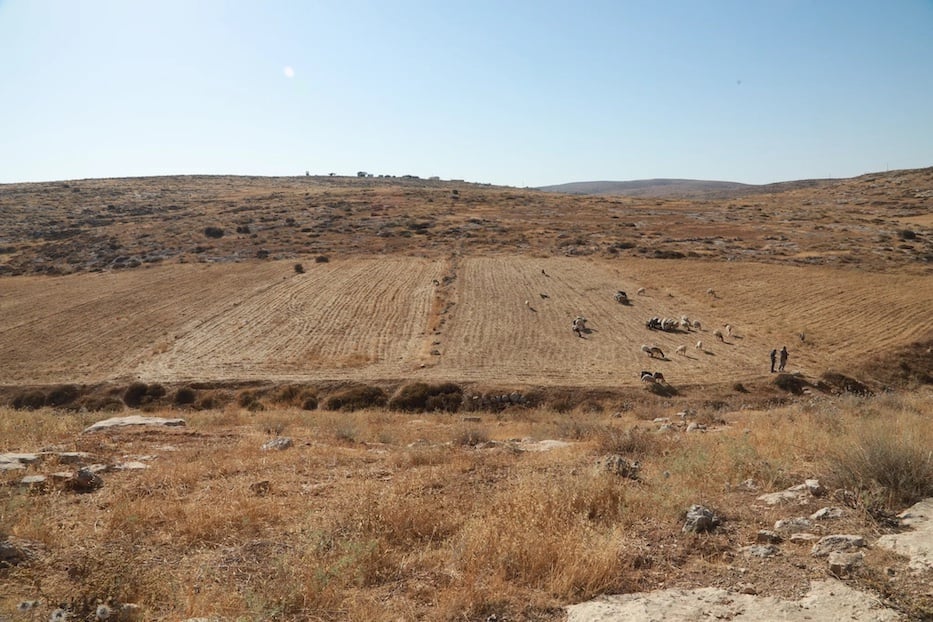
From the blog post "Balagan in Twaneh, July 15, 2023." Text and Photographs by Margaret Olin.
The photographs are what pull a viewer in, laying bare a power struggle that is decades in the making. At first, artist-activists Margaret Olin and David Shulman are simply walking through Wadi Jhesch, high enough in the South Hebron Hills to see Israeli settlers approaching. The shutter clicks: they meet a man waking from an afternoon nap in his truck bed. It clicks again: there are shepherds saying hello, the wooly bodies of sheep milling around the lower register of the frame. The sun makes the landscape glow.
Then the scene changes. A video cuts in, of an older man headed home to the town of Twaneh on his tractor. To the left, an Israeli soldier pulls him forward, one hand grasping at his jacket. The man yells out in Arabic, unsure of what he has done to deserve this abrupt assault. Around them, a small crowd has gathered, and started to record. Beneath a sea of voices, the tractor motor sputters and purrs, constant and mechanical.
The chaos—captured a full three months before Israel’s declaration of war on Hamas and ensuing airstrikes on Gaza this month—is part of Touching Photographs, a photo-journal documenting the stark, often violent Israeli occupation of Palestine through both Olin’s camera and Shulman’s words. Three weeks into a humanitarian crisis that has captured the globe’s attention, the images both teach a reader about the everyday violence of settler-colonialism and put an extremely human face to what is happening.
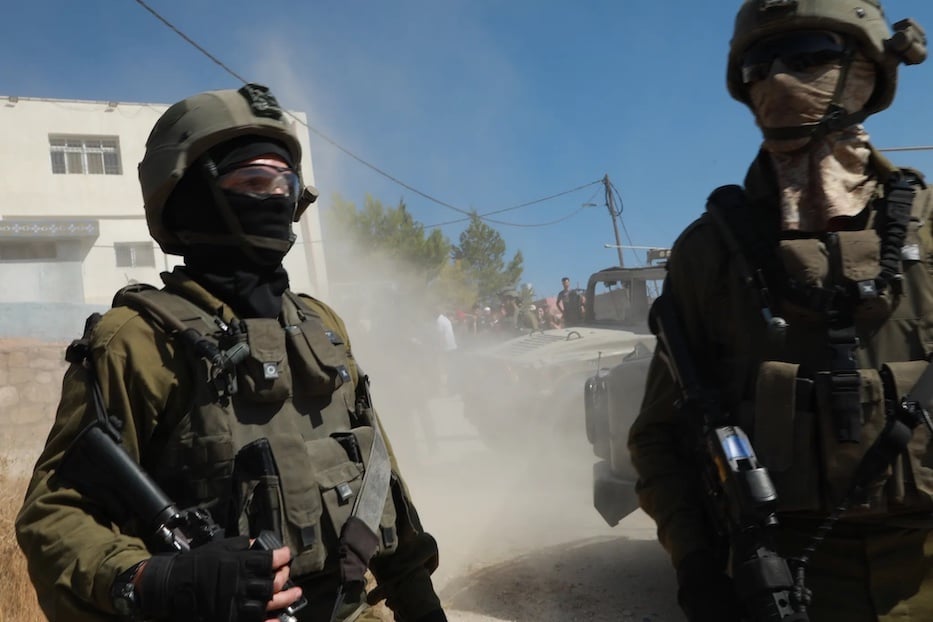
From the blog post "Balagan in Twaneh, July 15, 2023." Text and Photographs by Margaret Olin.
They are also a sort of living archive. Olin, a senior research scholar at Yale, member of Beth El-Keser Israel and longtime New Havener, and Shulman, an academic and activist who lives in Jerusalem, are in the process of publishing The Bitter Landscapes of Palestine, a book of 150 photographs that bear witness to the devastation, trauma and exhaustion of trying to survive in life under occupation.
“To me, what the photograph offers … it allows you some access to the texture of the experience that words [alone] can't give you,” Shulman said in a recent Zoom call from his Jerusalem apartment, back after spending the night volunteering in the village of Mu‘arrajat. “I think the mind, the human mind, has a tendency towards abstraction, and the result is that we lose the actual reality. A photograph doesn't give you the whole texture, but it does give you some kind of texture.”
Once the photograph is there, “it becomes a little harder to dehumanize or to objectify a human being,” he continued. “To turn a human being into a disposable object.”
And indeed, the images are a clear and explicit record of what Shulman has warned could be, and now feels like, a terrifying “second Nakba.” In the aftermath of Hamas attacks that left 1,400 Israelis dead and more missing earlier this month, over 8,000 Palestinians, including almost 3,200 children, have been killed in continuous, indiscriminate airstrikes on Gaza, according to Al Jazeera. Across the globe, including in New Haven, Hartford, and New Britain, millions of protesters have flooded the streets and taken over bridges, train stations and public spaces calling for a ceasefire.
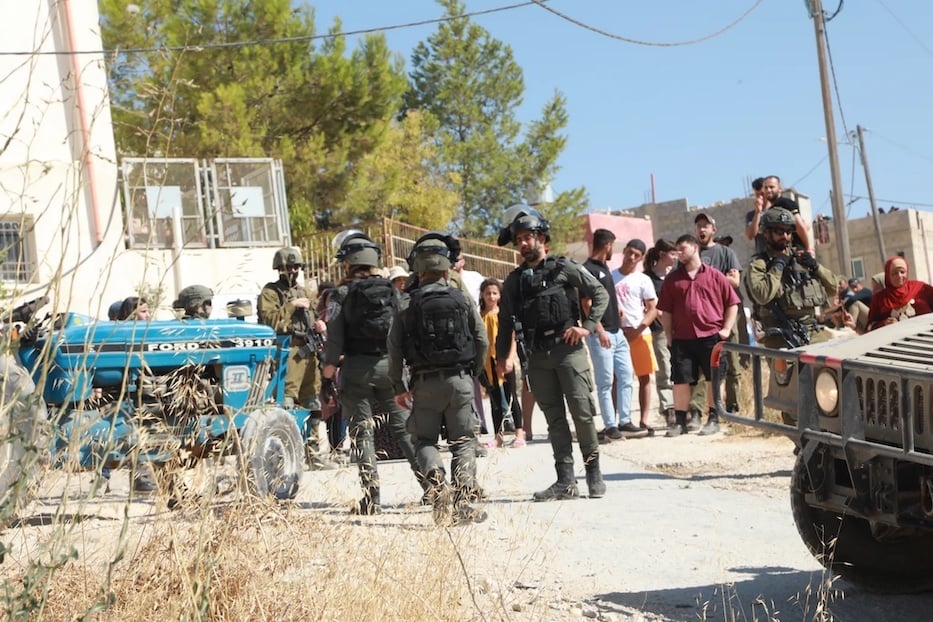
From the blog post "Balagan in Twaneh, July 15, 2023." Text and Photographs by Margaret Olin.
Many took place last Friday and Saturday, as airstrikes escalated to a complete blackout of internet and telecommunications infrastructure in Gaza. Against this backdrop, it is what the photographs, always presented with text, can teach a reader about the constant, everyday cruelty of settler-colonialism—and how quickly it can escalate to ethnic cleansing and genocide—that stands out as particularly trenchant in the moment (read more about Olin’s work, including her photographs of the Dheisheh Refugee Camp, here and here).
In a post from August 19 of this year, for instance, Olin has documented the demolition of a school building in Ein Samiya, a now-empty Palestinian village about an hour outside of Ramallah. Earlier this year, Israeli settlers and soldiers pushed forward in a long campaign to remove the village’s 200 remaining residents from their land, resulting in the flight of terrified villagers from their homes in late May. In Olin’s photographs, taken in July, she brings a viewer inside the school, where a scene of total devastation is flooded, somewhat chillingly, with golden light.
To the right of a broken windowpane, a cluster of construction-paper hearts remains untouched. Arabic lettering, done in thick black marker, scrawls neatly across their bright surfaces. On the floor, overturned tables lie on top of papers, assignments that will never be finished by the 78 youngest residents to flee the village in May. Crayon drawings hang high on a far wall; letters and numbers peek out from beside them. Strings of pink ribbon dangle from the handle of a single desk, just askew enough to suggest a breeze.
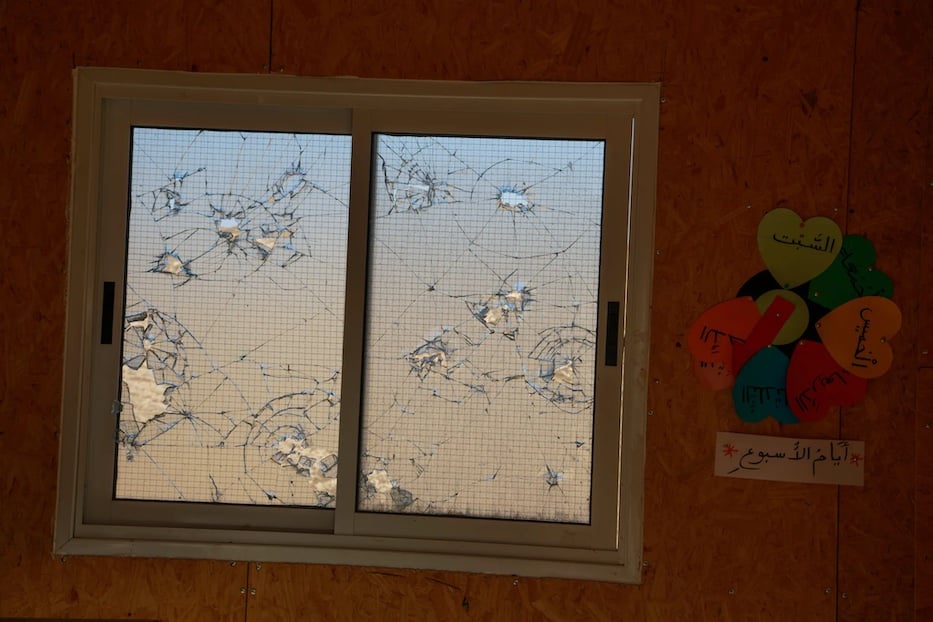
From ‘Ein Samiya, Al Baqa’a‘, Wadi a-Siq, July 19, 2023. Text and photographs by Margaret Olin.
Looking at the images, a viewer can feel their gut clench, that familiar, arrhythmic stopping and starting in their chest. There’s a familiarity there: this is the aftermath of a pogrom, a trauma reinforced and replicated by a nation-state built on a narrative of displacement. In this sense, it is as if Olin is speaking from behind the lens, repeating four simple words over and over again. Do not look away. Do not look away. Do not look away.
Shulman, who was in the village at the end of May, issued a similar warning to his readers when he was there. “I see my ancestors forced, repeatedly, into exile,” he wrote at the time. “And I see the Nakba reenacted—as the Israel right wants it to be, indeed is doing whatever it can to make this happen.”
On last week’s Zoom call, he added that the images also help to tell a fuller story of a long and unsettling history of aggression, escalating harassment, and gaslighting from settlers. In a pattern that has become as predictable as clockwork, Israeli settlers and soldiers in occupied territory often prohibit, deny permits to, and demolish schools as a way to physically, mentally, and emotionally harm Palestinians, including some of the youngest and most vulnerable among them.
“Palestinians, more than any community I’ve ever seen, are keen on educating their children,” Shulman said. “So they’ll build this school. So then, the civil administration, which is the army unit that runs the occupation, the civil administration will issue a demolition order because they were built without a permit. They will come and simply wreck this school.”
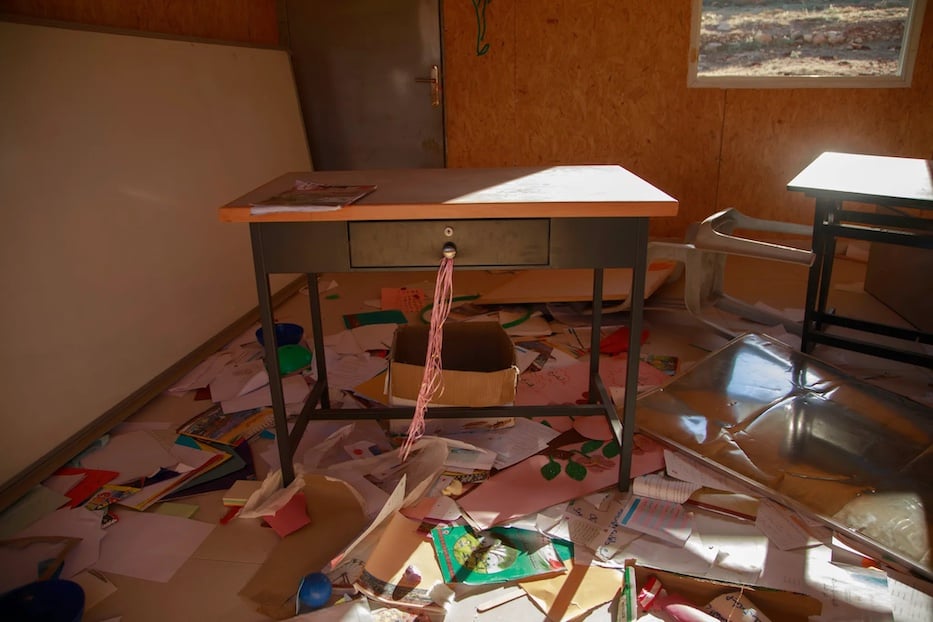
From ‘Ein Samiya, Al Baqa’a‘, Wadi a-Siq, July 19, 2023. Text and photographs by Margaret Olin.
“That's another thing about pictures,” he continued. “I don't think a person could look at these demolitions without being shocked and moved, horrified and all that. One could describe it, maybe, but it's not like seeing 20 pictures of these demolitions and what they look like in this desert landscape.”
So too in images of the landscape itself, which has become a sort of forced witness to the displacement of Palestinian residents from the land that has been rightfully theirs for millenia. In many of the photographs, some from as recently as last month, Shulman and Olin document fiery, dramatic desert sunrises and sunsets, shrubbery, trees and grasses and sheep dotting the dry and rocky land in the Jordan Valley and South Hebron Hills. It gives a viewer a sense of place beyond the smoking, flattened buildings that have dominated social media for the past three weeks.
They become an entry point into deeply human storytelling, from which a reader can learn about a history that goes so much farther back than October 7, or the last year, or the last five decades. In a dispatch from Ein Rashash dated to early September of this year (it includes both contemporary images and several from previous trips to the region), Shulman opens on an endangered village in the occupied West Bank, “hanging by a thread in the perilous space between life and death” as settlers invade the area and harass its residents. As he writes:
A massive program of ethnic cleansing is taking place before our eyes. Israeli settlers, religious in some perverted sense of the word, have perfected very effective methods to reach their goal. Readers of this blog are familiar with some of them.
While the landscape may be his way in—and there’s something uniquely arresting about its peace, and the notion of it being forcibly shattered by human intervention—Shulman focuses on the people who call it home, who have lived in caring and right relationship with the land for generations. In the most recent post, he tells the story of Haj Salameh Zawahra, a villager in his mid-80s who Israeli soldiers brutally beat and attacked in June for the simple fact of being present and alive.
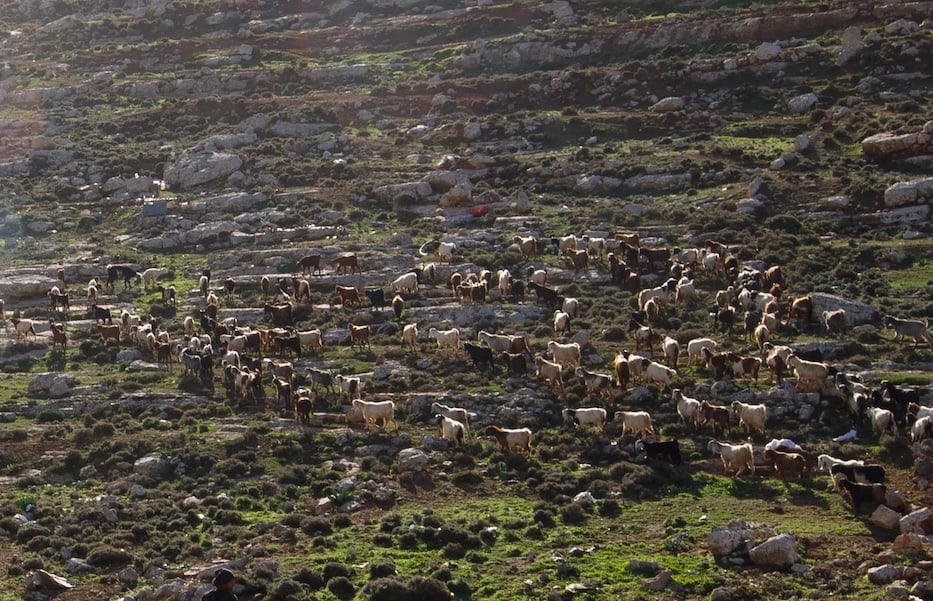
Ein Rashash in 2018. Margaret Olin Photo.
As Shulman writes, a reader learns that he is taking a shift watching the village, in a practice of physical solidarity and protection that he has since repeated in multiple villages during the current crisis. While his words detail the kindness of those around him—the breakfast that a family brings to keep him full, the words exchanged over hot, arid hours—it’s his photographs that make a viewer stop scrolling, and consider the weight and cost of what Israel is doing.
In one, Zawahra looks so frail, a sheen of sweat on his face as he reclines, one arm stretched out on a pillow in a way that cuts right into the foreground. In another, it’s his granddaughter who gives a reader pause, no older than four or five as she enters the frame in a pink dress and leggings, a tea kettle swinging from her right hand. Her eyes are soft; there’s still a whisper of those baby years in her flushed cheeks. Her brown hair, a long mess of curls, is fixed into a ponytail that flows down her back and frizzes over her brow.
There’s no world, Shulman says without ever having to say it at all, in which she should have to know terror.
“These are coming directly out of our shared experiences in the field,” Shulman said during the Zoom call. “And when you're there, we try to describe the experience. We want to somehow bring the reader, the viewer, into that world.”
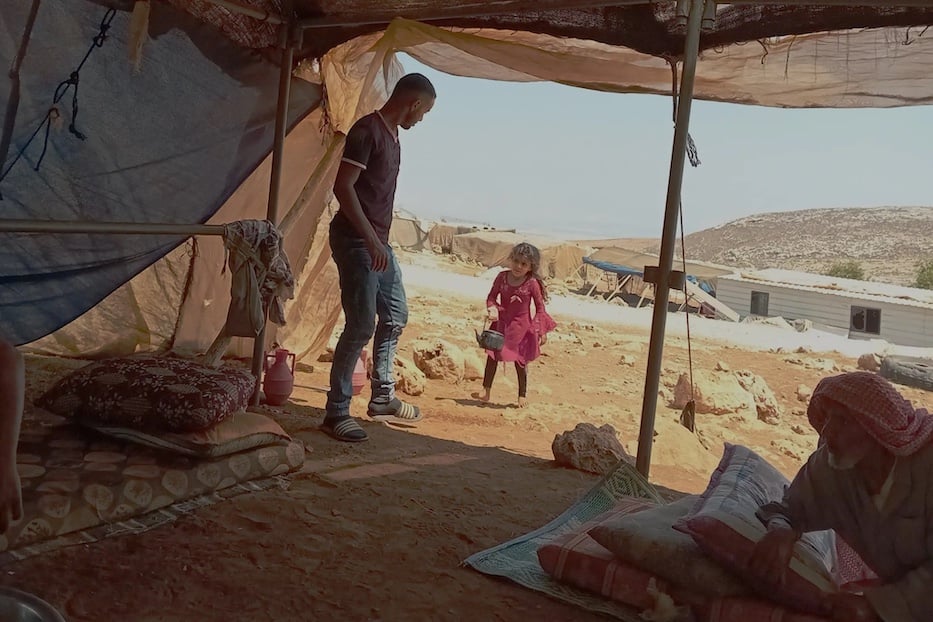
From "Ein Rashash, September 4, 2023." David Shulman Photo.
And indeed, there’s something about chronicling this long history of erasure, of telling it frankly and from the grassroots, that makes it harder to look away, to make oneself distant, to liken today’s violence in Gaza to 1973, but not to anytime in the past one or three or five or ten or 20 years.
It’s in exchanges from the village of Gawawis that start with pleasantries, then escalate to allegations of mistrust and lying, in the stillness of sheep grazing on a hillside over the Jordan Valley, in the kindness and trust of Bedouin farmers, who have not allowed themselves to become hardened and embittered to the world.
In other words, it is in the survival of a people who should never have had to wear this mantle of resiliency, and have been in return painted as sub-human and barbaric. And in Olin and Shulman’s able, steady hands, it is also an overdue reminder of their humanity.
“There’s something about the idea of the familiar and the unspeakable going together, which I think is one of the things that photographs do,” Olin said close to the end of last week’s Zoom interview, as a cat stretched behind her. “It’s also at play in situations where it’s your own town, your own country that’s being destroyed.”
“People that look like you … that maybe you know someone who knows someone who knows someone. It just makes it hit way harder. And I think that’s at play when people are more upset by what Hamas is doing than by what is being done to people in Palestine.”
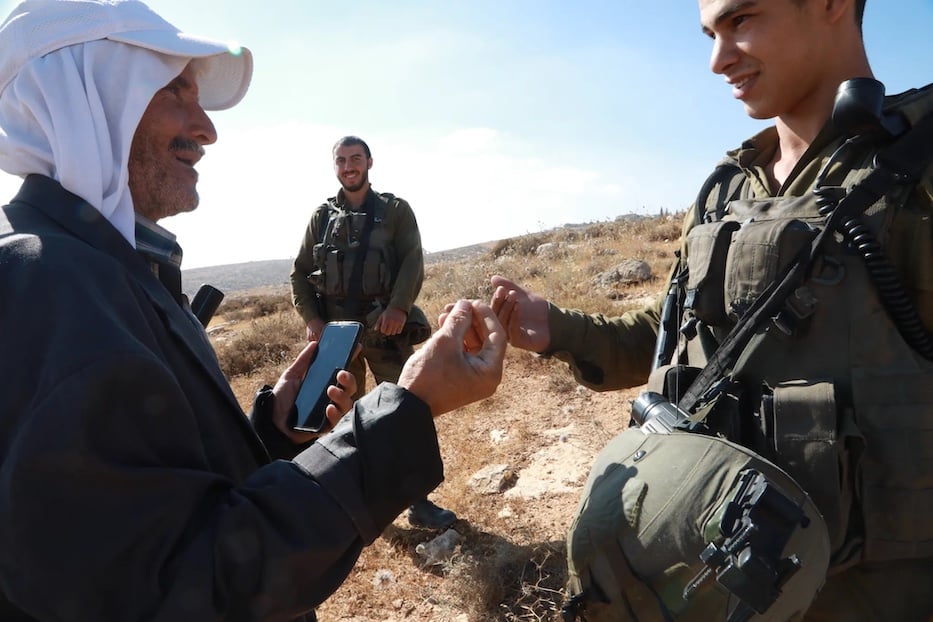
From "A Brief Conversation in Gawawis, July 8, 2023." Text and Photographs by Margaret Olin.
For now, both Olin and Shulman added, they are also working through how to capture the moment, and to the ongoing case for Palestinian liberation. Joining a Zoom call last week from Chicago, Olin said she can feel a split between her mind and her body, as one remains in the U.S. and the other roams the occupied Palestinian territory that she last visited over the summer. Now more than ever, she feels like she should be there.
She remembered walking by a school in New Haven days before her flight to Chicago, and feeling surprised by the fact that it was open. Children were playing on the playground outside: their laughter rippled out onto the sun-soaked sidewalk. “I thought ‘Wait, wait, school is in session?’” she remembered with a kind of quieted, disbelieving laugh. There were no soldiers, no civilian casualties standing between them and the school day, or Olin and her York Street office.
“I feel like I'm treading on thin ice no matter when I bring up the subject, no matter to whom and where,” she said. At times, she said, the current war reminds her of living on the South Side of Chicago in the 1960s, when she was still an undergraduate student at the University of Chicago.
“There was no wall, no checkpoint, but there might as well have been,” she said. Just weeks before she graduated, a classmate of hers was killed across the street from her apartment. Her friend, visiting from out of town, discovered the body. “I don’t talk about it very much because it’s too hard,” she said. “But I did not wish to bomb all of Woodlawn.”
When it comes to the history of Israel and Palestine, Shulman added, “there's plenty of ambiguity.” He noted that it is impossible for him to talk about what is happening, and not acknowledge the trauma that Israelis are also facing after attacks from Hamas in early October. “I think all of us in Israel are traumatized by the things that we saw—we're traumatized in a way that will not go away. We'll be carrying those things for the rest of our lives.”
“But,” he continued. “When you're in the South Hebron Hills, or in the Jordan Valley, and you're seeing what is happening there—the horrific, systemic course of violence that is being directed against those people, who are innocent people—then there's not much of a question as to what side you'd like to be on.”
Margaret (Peg) Olin and David Shulman’s The Bitter Landscapes of Palestine is forthcoming from Intellect Press in 2024. Learn more about it here. Read from “Touching Photographs” here.

